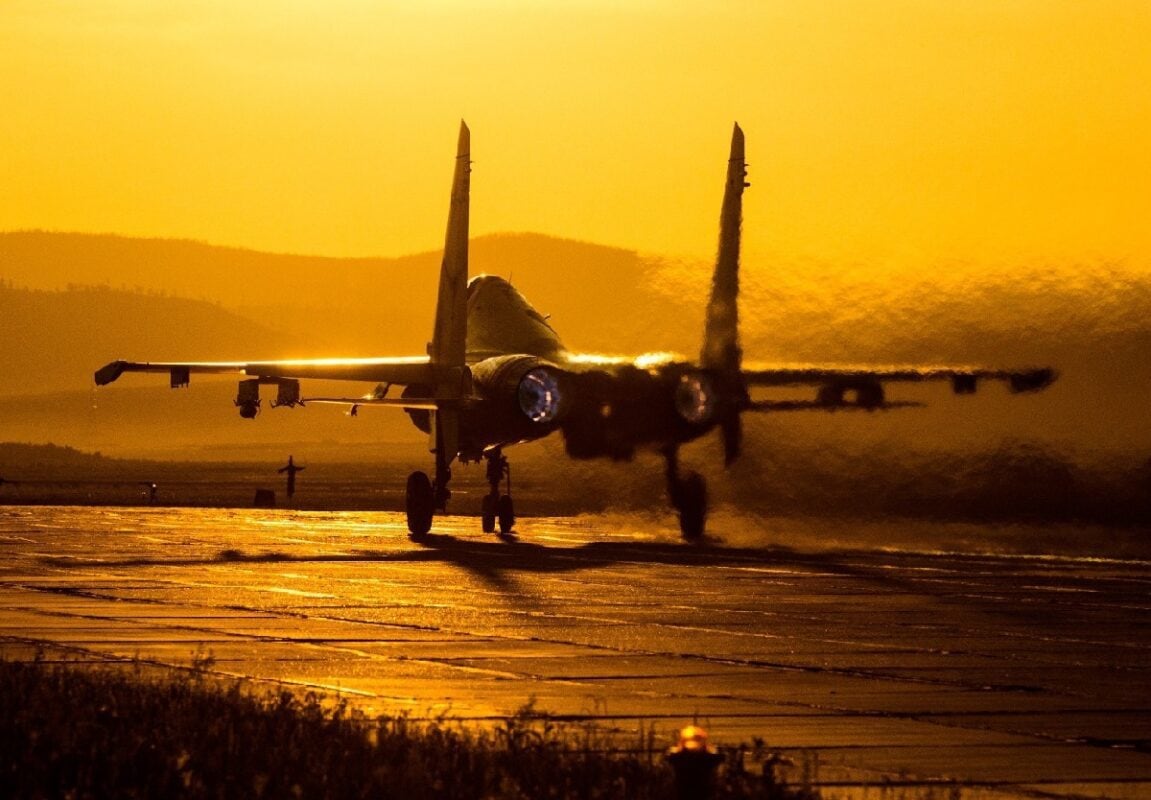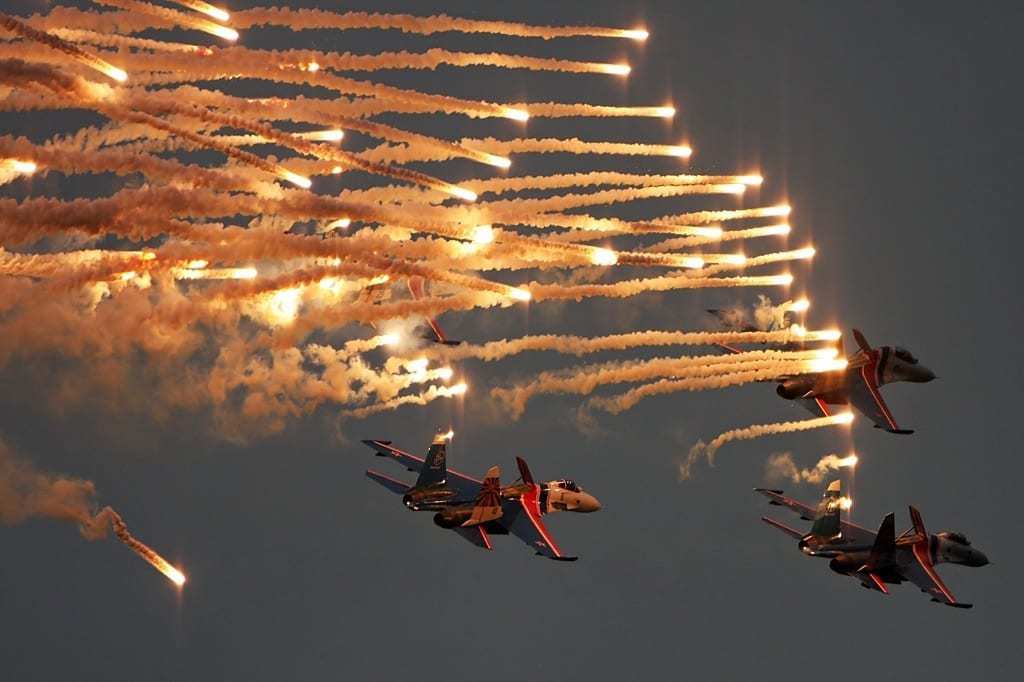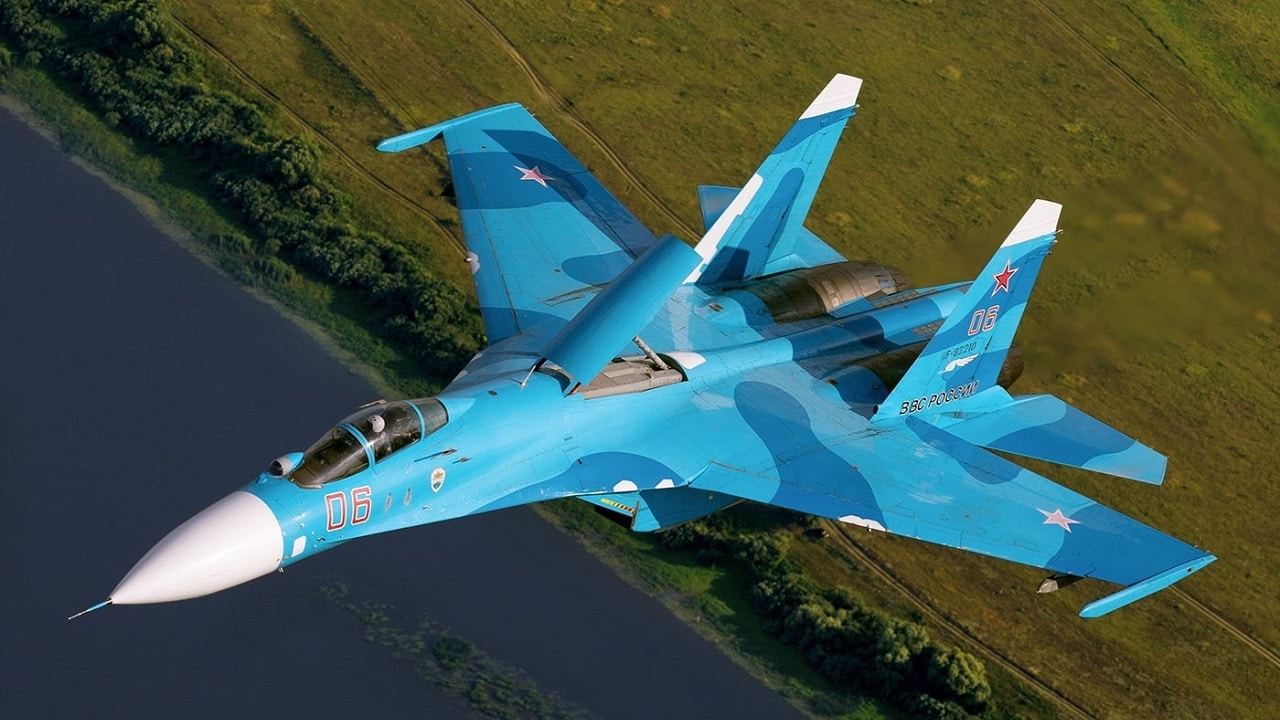Is the Su-27 now obsolete or needed now more than ever by the Russian Air Force? In the wide world of sports, the term “flanker” has a different meaning, depending on which particular sport you’re talking about. In American football, it’s one of the wide receiver positions, typically the farthest player from the center of the field, lined up a yard or so behind the line of scrimmage. In rugby union (but not in rugby league), which has 15 players on each team, the two flankers are the number 6 and 7 positions located on the “flanks” of the two forward packs.
But in the deadly “bloodsport” (so to speak) of air-to-air combat, the word “Flanker” has a far more ominous meaning to opponents: the Sukhoi Su-27 Flanker air superiority fighter.
Flankers Take Flight
The Su-27, being a 4th Generation fighter, essentially replaced the vaunted MiG-29 Fulcrum as the then-Soviet Union’s top-of-the-line fighter plane, meant to contend who the American F-15 Eagle and F-14 Tomcat as well as the U.S. strategic bomber fleet.
In theory, the “Fulcrum” was supposed to be a match for the F-15, but in actual combat against F-15s and F-16s alike over the skies of Iraq and Yugoslavia during 1991’s Operation Desert Storm and 1999’s Operation Allied Force respectively, the MiG-29 repeatedly came up with the short end of the stick.
Development of the “Flanker” actually began back in 1969, but it did not make its maiden flight until 20 May 1977, and from there deliveries were delayed until 22 June 1985, with the plane finally officially entering service in August 1990.
Su-27 Now Obsolete?
What made—and still makes—the Flanker such a special aircraft?
I’ll let the late Ukrainian Air Force Colonel—posthumous Hero of Ukraine medal awardee—address that question for you: “It’s powerful and accelerates well, especially on take-off. The Flanker is very sensitive in the rolling plane—you pull the stick to the side just a little, and it already wants to perform a barrel roll. When you pull up vertically, the Su-27 zooms across the sky, because of the great amount of available thrust,”
The warbird didn’t see its first official combat action until after the 1991 collapse of the Soviet Union. That proverbial “baptism of fire” took place during the 1992-1993 Georgia-Abkhazia War, and it was in that same war that the then-newfangled Sukhoi suffered its first combat loss, when Russian Air Force pilot Major Vatslav Aleksandrovich Shipko was KIA after his craft was downed in a friendly fire incident by an S-75M Dvina AKA SA-2 “Guideline” missile. Speaking of Georgia, the Russians would again deploy the “Flanker” in the 2008 South Ossetia War, gaining airspace control over the South Osetia capital city of Tskhinvali.
As far as I can ascertain (if I’m wrong, please make a note in our comments section), the first air-to-air combat involving the Su-27 took place during the Ethiopian-Eritrean War of 1999-2000. During that border conflict, Ethiopian-piloted Flankers shot down four Ethiopian Mig-29s and damaged another one, quite possibly the first instance of a Russian-made fighter jet shooting down its own immediate predecessor. Overall, prior the current “special military operation” in Ukraine, the Su-27 had garnered an air-to-air kill tally of 6:0. Though obviously not a ginormous statistical sampling, it nonetheless had placed the Flanker right up there with the F-15 and the Sea Harrier as one of the only three jet fighter aircraft with an undefeated air-to-air combat record.
Say Goodbye to that Perfect Record
That perfect aerial victory record of the Su-27 is no more. Back on 4 March 2022, four of Ukraine’s Flankers were shot down by their Russian enemies, who were most likely flying Su-35s. Thanks to the rapidly evolving nature of the current war, and the difficulty of separating verifiable facts from mere propaganda, actual kill-to-loss ratios for Ukrainian and Russian Su-27s are very much up in the air at this point (if you’ll pardon the bad pun), and I’ve yet to come across any official reports of actual Flanker vs. Flanker head-to-head match-ups. If and when such “fratricidal Flanker” (so to speak) battles take place, the Russian versions will have a distinct technological advantage, as explained in sobering detail by by 19FortyFive colleague Brent M. Eastwood:
“The Russians are using new R-37M missiles compared to the R-27 the Ukrainians employ on their Su-27. The R-37M has five times the range compared to the R-27. The R-37M also flies at MACH 6 and is one of the best air-to-air missiles deployed today…The Ukrainian Su-27 has fallen behind in numerous other areas. Military Watch said the ‘use of active rather than semi-active radar guidance on missiles, thrust/weight ratio, endurance, electronic warfare systems and countermeasures, cockpit displays, and perhaps most importantly data links for network centric warfare, all provide the modern Russian Su-27 derivatives with a tremendous advantage.’”

Image: Creative Commons.

Russian Knights paying tribute to Igor Tkachenko, leader of the group who died during practice a week earlier.
Time will tell if the courage and the motivation of the Ukrainian Flanker drivers will be enough to at least partially overcome their on-paper technological disadvantages. Stay tuned.
Christian D. Orr is a former Air Force officer, Federal law enforcement officer, and private military contractor (with assignments worked in Iraq, the United Arab Emirates, Kosovo, Japan, Germany, and the Pentagon). Chris holds a B.A. in International Relations from the University of Southern California (USC) and an M.A. in Intelligence Studies (concentration in Terrorism Studies) from American Military University (AMU). He has also been published in The Daily Torch and The Journal of Intelligence and Cyber Security. Last but not least, he is a Companion of the Order of the Naval Order of the United States (NOUS).

